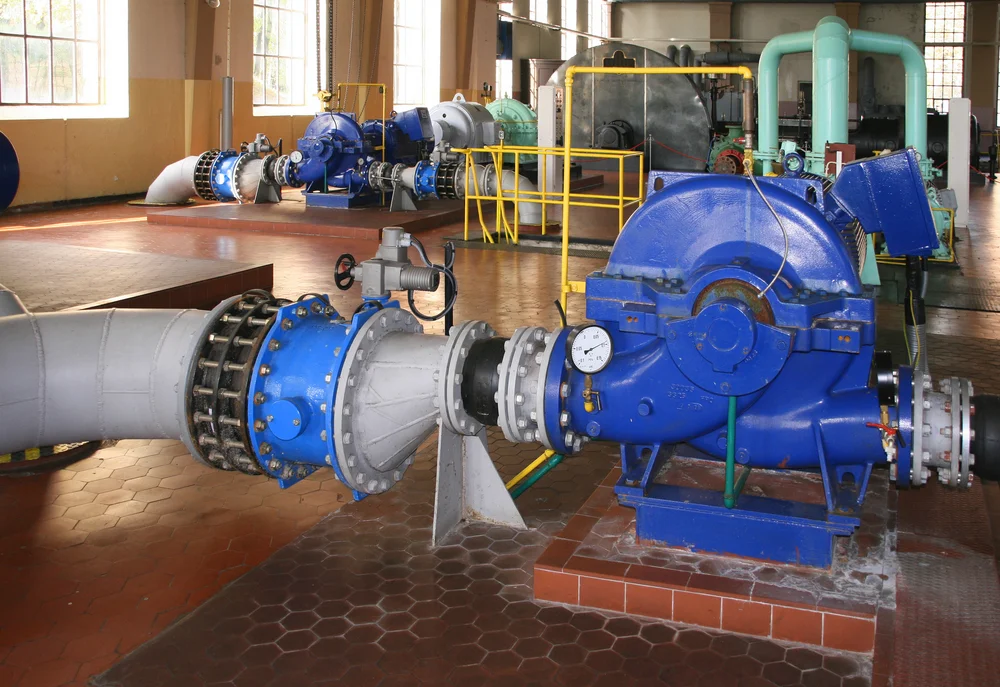Rising above the silos
/John Tonkin
The importance of inter-departmental teamwork in increasing Mean Time Between Failures (MTBF).
I was recently called to a site where a pump had failed, and arrived to this:
How not to do it.
After a quick assessment, the following errors were obvious:
- Mild steel cable was used on a stainless-steel pump end.
- The cable has been tied on the wrong end of the pump.
- The motor (not shown) failed due to poorly-specified electrical protection.
- Insulation tape was used to tie the motor lead cable onto the riser pipe.
- The final straw was that the motor and pump were mismatched.
A people problem
Unfortunately, this is not the first failed pump I’ve assessed – not by a long shot… Some of the pumps I’ve seen have failed due to environmental challenges – high temperature water, pebbles in the groundwater, high salt content in the water, and so on. I’ve also seen a few installations that have failed due to poor-quality equipment being used.
But in this case, the failure was not due to environment or equipment problems. Instead, it was a people problem. The decision-making that went into the installation process was faulty. And there wasn’t just one person to “blame” either.
Then, I happened to come across this article on “silo mentality”, which happens when departments in a company refuse to share information or collaborate with members of other departments in the same company. The result is decreased efficiency and declining morale, which could ultimately lead to the demise of the whole company.
Now if I think back to the many pump installation failures I’ve seen, this idea of silo mentality is a common thread running through most of them. Many installations fail due to poor or non-existent communication or lack of a teamwork ethic. Electrical does the electrics, mechanical does the mechanicals, while hydrogeology does the calculations!
Unfortunately, changing people’s mindsets is a bit more difficult than changing the 400kW pump that has just failed, but if we want to see our pump installations lasting beyond their 21st birthdays, then that’s exactly where we’re going to have to start – breaking down the barriers of silo mentality.
Luckily, Brent Gleeson and Megan Rozo, the authors of the article I mentioned, have some strategies to break down the barriers created by organisational silos. In this article, I will go through each of these strategies and apply them to a pump installation.
Create a unified vision: Increase MTBF
The first step in silo-busting is to create a unified vision that everyone can get behind. I have found that the unified vision for any organisation involved in a pump installation is to increase the Mean Time Between Failures (MTBF). Whether you’re on a mine, an industrial plant, a farm, or a residential garden, I’m sure that you’d like to have as few pump failures as possible.
So if everyone in your company (whether that is a collection of individual contractors, or a major corporation) can agree that every action needs to contribute to increasing MTBF, then you are already a fair way on the journey towards breaking those barriers.
Work towards achieving the goal of increased MTBF
Once the leadership team has established the unified vision, then each department and individual needs to work together to realise that vision. This is a challenge because each team will need to do something different, but their actions together will contribute towards the achievement of the unified vision.
I'd like to highlight two situations where operating in silos has resulted in faulty decision-making - sizing the borehole based on the size of the pump, and sizing the pump based on the size of the motor.
Sizing the borehole based on the size of the pump
I’ve seen so many errors being made because the team in charge of drilling is not working with the team in charge of doing the pump selection and purchasing. The result has been that the borehole is sized, based on the size of the pump. Please allow me to venture into some maths to show how unproductive (and absurd) this practice could become.
As the end-user was set up for low-voltage supply and piping systems that had pressure limitations, this would have required significant changes to electricity reticulation and a complete redesign of the water system. As if these constraints were not bad enough, the size of the borehole that would have to be drilled would be nothing less than one metre in diameter! This would have all been an extremely costly exercise.
So, attempting to size a pump before the drilling and testing is completed is a recipe for failure(s). There are no short cuts to having a good understanding of the potential of the formations drilled and a well-defined yield test program to select the most appropriate pumping system for a borehole.
Sizing the pump based on the size of the motor
The other error I’ve identified is that the size of the pump required is determined purely on the size of the motor that is available. I’ve heard questions like, “How much is your 1,1kW pump?” Meanwhile, there are nine different 1,1kW pumps in the catalogue.
Or another one, “I need to replace a 300kW with a 93kW pump.” But the pump supplier has no less than thirteen 93kW pumps in their catalogue. These range from high capacity/low TDH to low capacity/high TDH. Quite a choice to make! And then I’d like to ask the question, “Why are you replacing the pump?” Because the 93kW pump might end up being too small, or even too big. But if you keep trying different pump sizes as a matter of trial and error, you are bound to end up with multiple failures (and a rather steep account) along the way.
Pumps that are too big waste significant amounts of expensive energy and have low Mean Times Between Failures (MTBF). Pumps that are too small show the same results, albeit for different reasons. Poor plant reliability figures due to repeat failures bring with them a whole set of additional problems.
Each pump and motor combination is designed to operate within a TDH/capacity duty RANGE. Depending on the specific capacity of the borehole, there might be one of a few 93kW pumps that would be the optimum selection. For this reason, it is essential that step and constant-rate tests be done (by the geohydrology team for example), so that the dewatering and procurement team can have enough information to do their jobs.
The engineering team needs to ensure that sound borehole construction techniques are used in their designs, and the drillers need to drill to acceptable standards, and seek advice from the installation team that will have to equip the hole when they are done. Each team forms an integral part of a cost-effective borehole installation.
Motivate and incentivise
Gleeson and Rozo point out that,
All of the tactics described within Motivation are designed to avoid the “it’s not my job” attitude and encourage input, team work, and most importantly – productivity.
So in working towards a high MTBF, the company leadership will need to ensure that the behaviours that are being rewarded are those that encourage “input, teamwork, and most importantly – productivity.”
All too often, a company will (intentionally or not), reward individual performance over team productivity, with the result that people will retreat into their silos, protect their turf, and sabotage the efforts of other teams, even if it means that the common vision is not achieved. After all, this is the behaviour that is being rewarded.
But instead, if incentives are geared towards teamwork and collaboration, the barriers inherent in the silo mentality will be broken down – not only because this behaviour is being rewarded, but also because “the daily grind” will become a lot more fulfilling when you can see that you’re making real progress towards achieving an important goal.
Execute and measure
This is the part where the commitments outlined in the shared vision and common goals are transformed into action. All individuals involved must execute the plan on a day-to-day basis.
Very importantly, there must be a process of measuring progress towards the shared goal. If you can get accurate information about how your pumps are running, then you will be able to make decisions long before crisis point. This involves replacing a run-to-failure approach with data collection and performance monitoring.
I’ll illustrate with an example of a borehole that had an average lifespan of between eight months to a year. Historical records showed catastrophic failure of both pump and motor resulting in exorbitant replacement costs. Subsequently, this run-to-failure approach was replaced with data collection and performance monitoring, and this was the result:
Condition monitoring of a large diameter borehole
This graph shows an increase in the capacity delivered by the pump on 24th June, which was achieved by increasing the speed. From then on, the capacity shows a consistent downward trend indicating a suction or discharge or wear-and-tear problem. Using this information, the appropriate action was taken in time thereby reducing repair costs and drastically improving plant reliability.
Collaborate and create
The final strategy is to encourage a culture of collaboration and creation within and between all teams in the organisation. This could take the form of cross-departmental training. I have been witness to countless “a-ha” moments during a training session, just because two people from different departments finally had the chance to see the other one’s point of view of a particular problem being discussed.
Part of this will also mean eliciting feedback from other departments and putting processes in place to make collaboration a normal part of your day. And I know many of you might be cringing at the thought of asking for the opinions of colleagues you may have butted heads with in the past, but in the long-run, you will reap many rewards – both in terms of achieving your company’s common vision, and playing your part in creating a happier, more productive workplace.
It is essential that each department has a basic understanding of the challenges facing their colleagues in other departments and can engage in meaningful communication. The mechanical member of the team for example would not be required to rewire a star-delta panel but they should understand the possible causes of why the current and/or real power has increased in a short space of time.
Are you ready to rise above the silos?
Breaking down the barriers that years of “silo construction” have created is going to be a challenge. And you may feel that this is a problem that needs to be addressed “from the top”. However, if you’ve read to the end of this article, I know that you realise the importance of collaboration and teamwork, and so I challenge you to take one small step in your workplace to encourage collaboration and break down the barriers created by the silos in your organisation.






